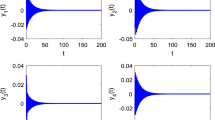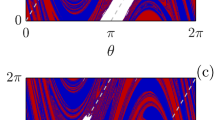Abstract
Results regarding probable bifurcations from fixed points are presented in the context of general dynamical systems (real, random matrices), time-delay dynamical systems (companion matrices), and a set of mappings known for their properties as universal approximators (neural networks). The eigenvalue spectrum is considered both numerically and analytically using previous work of Edelman et al. Based upon the numerical evidence, various conjectures are presented. The conclusion is that in many circumstances, most bifurcations from fixed points of large dynamical systems will be due to complex eigenvalues. Nevertheless, surprising situations are presented for which the aforementioned conclusion does not hold, e.g., real random matrices with Gaussian elements with a large positive mean and finite variance.
Similar content being viewed by others
References
Random matrices and their applications, volume 50 of Contemporary mathematics. AMS (1986).
R. Adams and J. J. F. Fournier, Sobolev Spaces, 2nd edition (Elsevier, 2003).
D. J. Albers, J. P. Crutchfield and J. C. Sprott, Phenomenological scaling in the organization of high-dimensional dynamics. In preparation.
D. J. Albers and J. C. Sprott, Routes to chaos in high-dimensional dynamical systems: A qualitative numerical study. submitted, see http://www.santafe.edu/∼albers/research/publications.html (2005).
D. J. Albers and J. C. Sprott, Structural stability and hyperbolicity violation in high-dimensional dynamical systems. Nonlinearity 19: 1801–1847 (2006).
D. J. Albers, J. C. Sprott and W. D. Dechert, Routes to chaos in neural networks with random weights. Int. J. Bif. Chaos 8: 1463–1478 (1998).
S. Amari. Characteristics of random nets of analog neuron-like elements. IEEE Trans. Syst. Man. Cyb., SMC-2 N 5: 643–657 (1972).
S. Amari, H. Nagaoka and S.-I. Amari, Methods of Information Geometry. Translations of Mathematical Monographs. AMS (2001).
D. K. Arrowsmith and C. M. Place, An Introduction to Dynamical Systems (Cambridge University Press, 1990).
Z. D. Bai, Circular law. Ann. Probab. 25: 494–529 (1997).
P. Brunovsky, On one parameter families of diffeomorphisms. Commentationes mathematicae Universitatis Carolinae 11: 559–582 (1970).
B. Cessac, B. Doyon, M. Quoy and M. Samuelides, Mean-field equations, bifurcation map and route to chaos in discrete time neural networks. Physica D 74: 24–44 (1994).
B. Doyon, B. Cessac, M. Quoy and M. Samuelides, Control of the transition to chaos in neural networks with random connectivity. IJBC 3: 279–291 (1993).
B. Doyon, B. Cessac, M. Quoy and M. Samuelides. On bifurcations and chaos in random neural networks. Acta Biotheo. 42: 215–225 (1994).
A. Edelman, The probability that a random gaussian matrix has k real eigenvalues, related distributions, and the circular law. J. Multivariate Anal. 60: 203–232 (1997).
A. Edelman and E. Kostlan, How many zeros of a random polynomial are real? Bull. Amer. Math. Soc. 32: 1–37 (1995).
A. Edelman, E. Kostlan and M. Shub, How many eigenvalues of a random matrix are real? J. Am. Math. Soc. 7: 247–267 (1994).
A. Edelman and H. Murakami, Polynomial roots from companion matrix eigenvalues. Math. Comput. 64: 763–776 (1995).
R. Gencay and W. D. Dechert, An algorithm for the n Lyapunov exponents of an n-dimensional unknown dynamical system. Physica D 59: 142–157 (1992).
J. Ginbre, Statistical ensembles of complex, quaternion and real matrices. J. Math. Phys. 6: 440–449 (1965).
V. Girko, Circular law. Theory Probab. Appl. 29: 694–706 (1984).
V. Girko, Theory of Random Determinants (Kluwer Academic, 1990).
V. Girko, The circular law: Ten years later. Random Oper. and Stoch. Eqns. 2: 235–276 (1994).
V. Girko. Strong circular law. Random Oper. and Stoch. Eqns. 5: 173–196 (1997).
V. Girko, The V-density of eigenvalues of non-symmetric random matrices and rigorous proof of the strong circular law. Random Oper. and Stoch. Eqns. 5: 371–406 (1997).
V. Girko, The strong circular law. Twenty years later. Part I. Random Oper. and Stoch. Equ. 12: 49–104 (2004).
V. Girko, The strong circular law. Twenty years later. Part II. Random Oper. and Stoch. Equ. 12: 255–312 (2004).
V. Girko, The strong circular law. Twenty years later. Part III. Random Oper. and Stoch. Equ. 13: 53–109 (2005).
R. Horn and C. Johnson, Matrix Analysis (Cambridge Univerisity Press, 1985).
K. Hornik, M. Stinchocombe and H. White, Mulitlayer feedforward networks are universal approximators. Neural Networks 2: 359–366 (1989).
K. Hornik, M. Stinchocombe and H. White, Universal approximation of an unknown mapping and its derivatives using multilayer feedforward networks. Neural Netw. 3: 551 (1990).
B. R. Hunt, T. Sauer and J. A. Yorke, Prevalence: a translation invariant “almost everywhere” on infinite-dimensional spaces. Bull. Am. Math. Soc. 27: 217–238 (1992).
B. R. Hunt, T. Sauer and J. A. Yorke, Prevalence: an addendum. Bull. Am. Math. Soc. 28: 2306–307 (1993).
M. Kac, On the average number of real roots of a random algebraic equation. Bull. Am. Math. Soc. 49: 314–320 and 938 (1943).
H. Kantz and T. Schreiber, Nonlinear Time Series Analysis, 2nd edition (Cambridge University Press, 2003).
E. Kanzieper and G. Akemann, Towards spectral theory of Ginibre's ensemble of real random matrices. Phys. Rev. Lett. 95: 230201 (2005).
A. Katok, Lyapunov exponents, entropy, and periodic orbits for diffeomorphisms. Publ. Math. I.H.E.S. 51: 137–174 (1980).
Y. Kuznetzov, Bifurcation Theory, 2nd edition (Springer-Verlag, 1998).
M. L. Mehta, Random Matrices, chapter 15 (Elsevier, 2004).
O. Moynot and M. Samuelides, Large deviations and mean-field threory for asymmetric random recurrent neural networks. Probab. Theory Relat. Fields 123: 41–75 (2002).
J. Neimark, On some cases of periodic motions depending on parameters. Dokl. Acad. Nauk SSSR 129: 736–739 (1959).
V. I. Oseledec, A multiplicative ergodic theorem. Lyapunov characteristic numbers for dynamical systems. Tras. Moscow Math. Soc. 19: 197–221 (1968).
W. Ott and J. Yorke, Learning about reality from observations. SIAM J. Appl. Dyn. Syst., 3: 297–322 (2003).
W. Ott and J. A. Yorke, Prevalence. Bull. Am. Math. Soc. 42: 263–290 (2005).
Y. B. Pesin, Lyapunov characteristic exponents and smooth ergodic theory. English Transl. Russian Math. Surv. 32: 55–114 (1977).
D. Ruelle, Characteristic exponents and invariant manifolds in Hilbert space. Ann. Math. 115: 243–290 (1982).
R. Sacker, On invariant surfaces and bifurcation of periodic solutions of ordinary differential equations. Technical Report 333 (New York State University, 1964).
T. Sauer, J. Yorke and M. Casdagli, Embedology. J. Stat. Phys. 65: 579–616 (1991).
H. Sompolinsky, A. Crisanti and H. J. Sommers, Chaos in random neural networks. Phys. Rev. Lett. (1988).
J. Sotomayor, Structural stability and bifurcation theory. Dyn. Syst. 549–560 (1973).
J. C. Sprott, Chaos and Time-series Analysis (Oxford University Press, 2003).
F. Takens, Detecting atrange attractors in turbulence. In D. Rand and L. Young (Eds.), Lecture Notes in Mathematics, vol. 898, pp. 366–381, Dynamical Systems and Turbulence, Warwick (Springer-Verlag, Berlin, 1981).
S. Wiggins, Global Bifurcations and Chaos: Analytical Methods (AMS. Springer-Verlag, 1988).
S. Wiggins, Introduction to Applied Nonlinear Dynamical Systems and Chaos, vol. 2 of TAM. (Springer-Verlag, 1994).
Author information
Authors and Affiliations
Corresponding author
Additional information
PACS numbers: 05.45.−a, 05.45.Tp, 89.75.−k, 89.75.Fb
Rights and permissions
About this article
Cite this article
Albers, D.J., Sprott, J.C. Probability of Local Bifurcation Type from a Fixed Point: A Random Matrix Perspective. J Stat Phys 125, 885–921 (2006). https://doi.org/10.1007/s10955-006-9232-6
Received:
Accepted:
Published:
Issue Date:
DOI: https://doi.org/10.1007/s10955-006-9232-6




